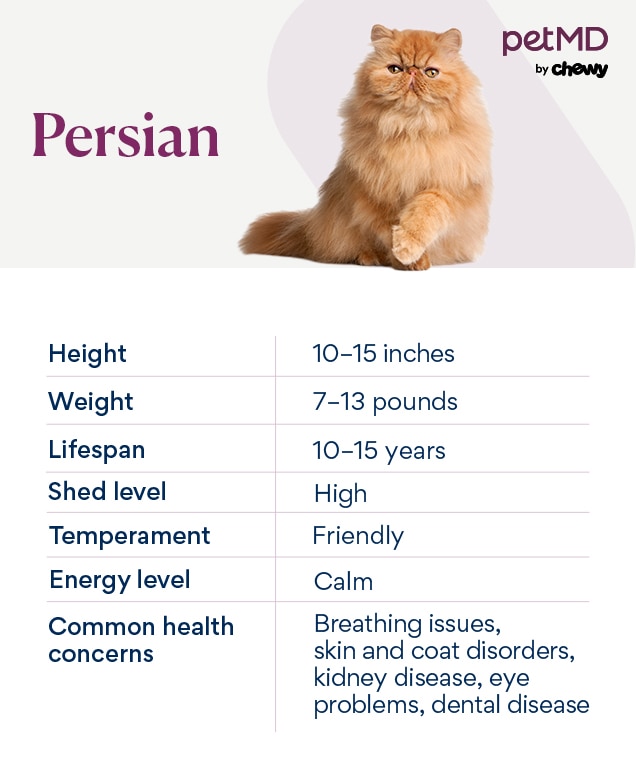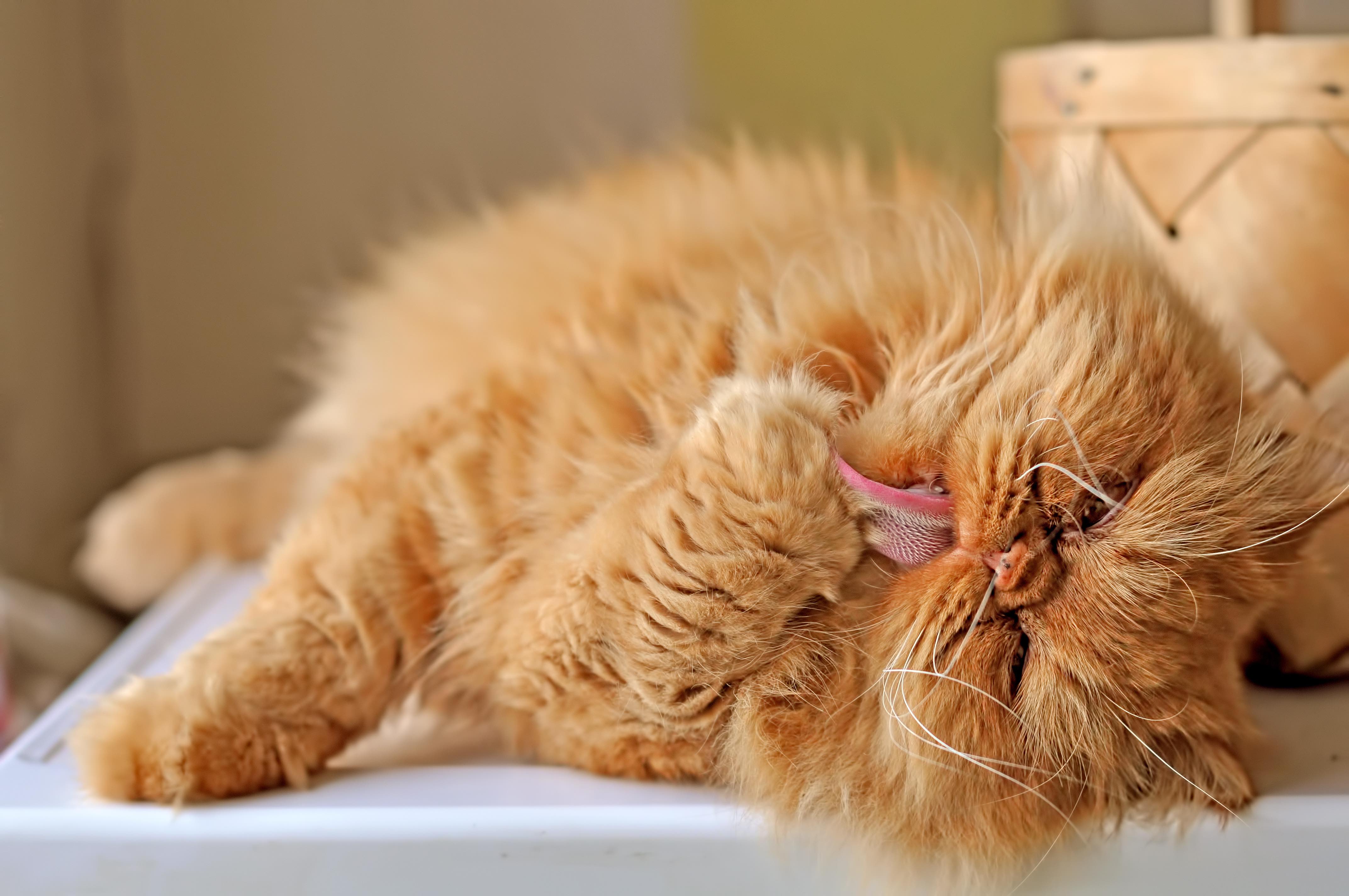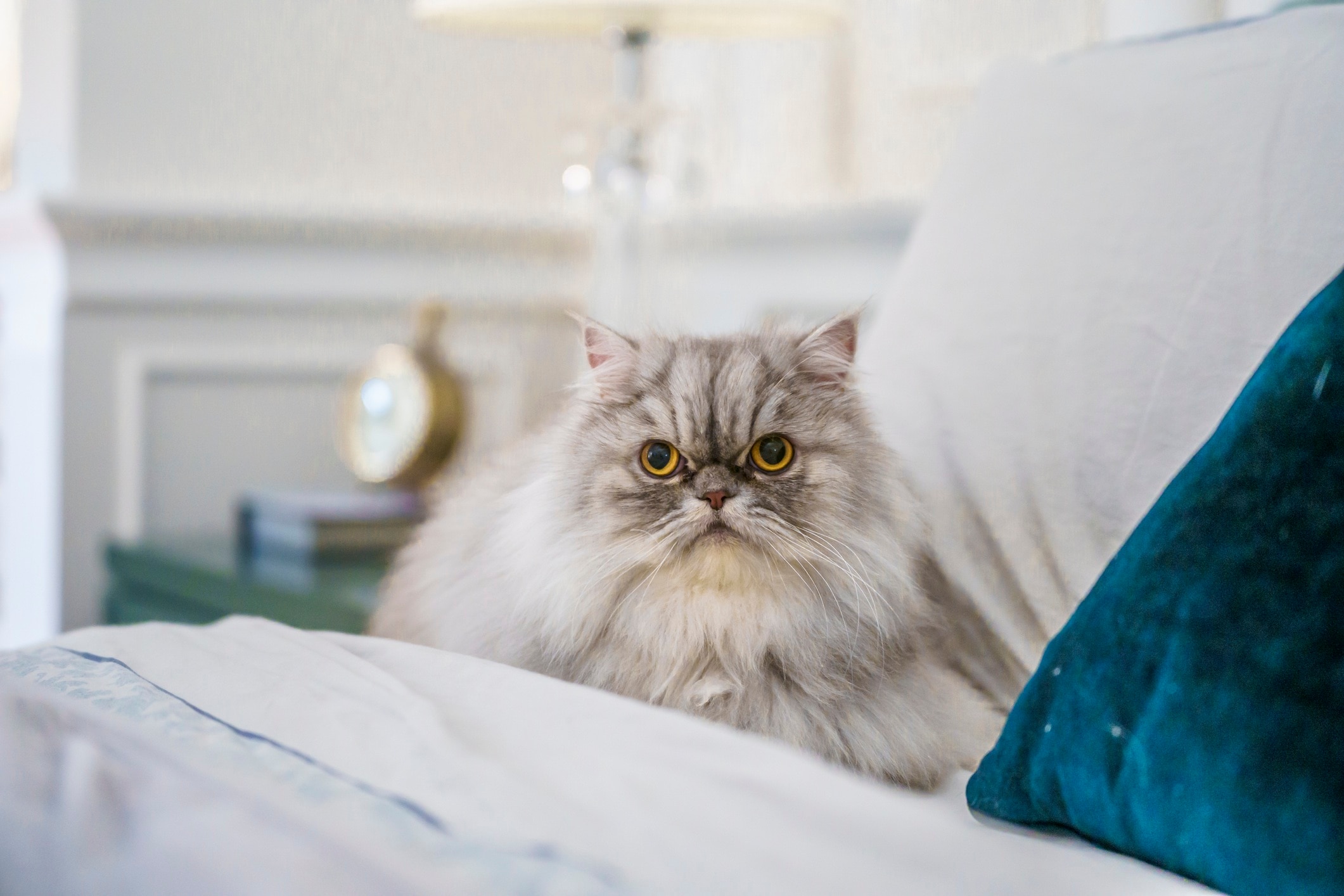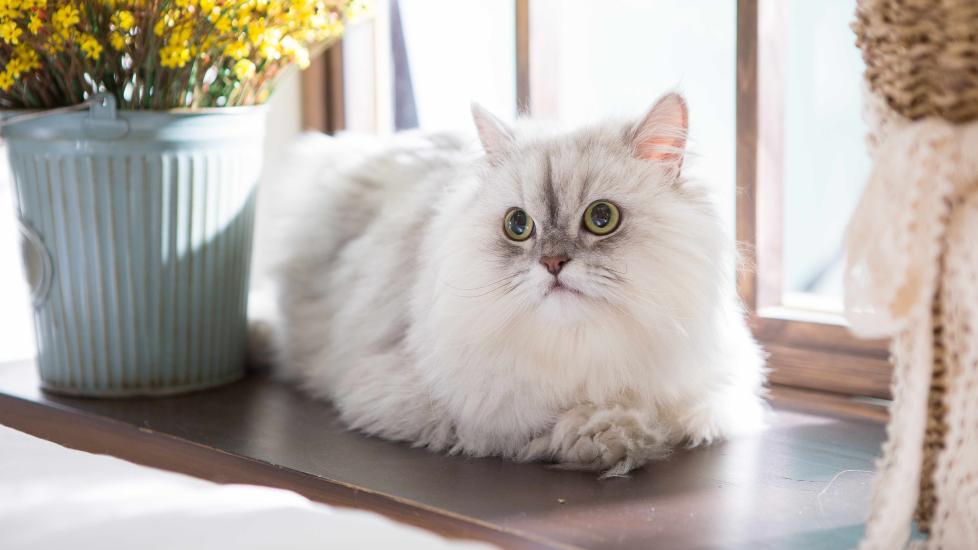Persian
Persian cats are thought to be one of the oldest cat breeds, dating as far back as the 1600s. They appear in Persian historical records as “the long-haired beauties,” says Maggie Shuter, a Certified Feline Behavior Consultant (CFBC). Cat-lovers and historians alike say Persians roamed the world as popular companions on caravans and alongside world travelers. Even Queen Victoria had two Persians, and in 1871 the sought-after breed made a show-winning appearance at the very first modern cat show.
Today, Persian cats continue to charm their way to the top of popular breed lists. While they come with a fair share of fur maintenance, Persians are docile, intelligent, and make great companions in mellow households. And while they come in over 50 shades and color combinations, Persian cats are easily identified by their smooshed-in faces, big eyes, and lustrous coats. They have stocky bodies, averaging 10–15 inches in height and weighing 7–13 pounds.
Caring for a Persian Cat

Persians didn’t always have flat faces, Shuter says. The trait is a result of a random genetic mutation that quickly became popular among breeders who wanted a "peke" look, similar to Pekingese dogs. Although their flat faces make them popular pets, Persians require specific grooming and medical care.
Cute and sweet-tempered, it’s easy to see why anyone would want to snuggle up with a Persian cat. However, Persians are typically reserved and wary of new people. Once they warm up, Shuter says, they form deep bonds with their family members. “They are known to be relaxed and to enjoy bonding by sitting with humans,” she says, “and being petted rather than showing love through play, though they certainly do have occasional bursts of energy.”
Persian Cat Health Issues
Persian cats have a lifespan averaging 10–13 years. Because they are prone to certain health conditions, it may be beneficial to purchase pet insurance for your Persian kitten.
Hydrocephalus
Persian kittens with extreme brachycephaly are at a higher risk of developing hydrocephalus, an abnormal expansion and accumulation of cerebrospinal fluid (CSF) in the cavities of the brain.
Signs of congenital hydrocephalus typically appear within the first few weeks to a year after birth and include seizures, a dome-shaped head, abnormal breathing, and failure to thrive. Cats with hydrocephalus may require surgery.
Brachycephalic Airway Syndrome
Brachycephalic airway syndrome is a group of upper airway issues often seen in flat-faced cats and dogs. Brachycephalic breeds often have trouble breathing due to physical traits such as narrowed nostrils, an elongated soft palate, or larynx (voice box) collapse. An abnormally small trachea may also cause breathing difficulties. This condition can limit a Persian's ability to exercise and tolerate heat, particularly in overweight cats, senior cats, or cats with allergies.
If you ever notice your cat breathing with an open mouth, this is a medical emergency and they should see their vet right away.
Skin and Coat Disorders
Persians have abnormally long fur due to a genetic mutation that interferes with hair protein function. This makes them more prone to coat and skin issues, such as fungal and bacterial skin infections.
Polycystic Kidney Disease
Polycystic kidney disease (PKD) is a genetic condition that causes cysts to form in the kidneys, resulting in permanent damage. Kidney damage impairs waste filtration, fluid balance, and proper hormone production. Fortunately, genetic testing can help prevent the disease in kittens by identifying carriers, so ask your Persian breeder about the breeding parents' test results. At-home DNA kits can also detect PKD in cats before symptoms appear.
Symptoms of PKD are very similar to those of kidney disease in cats and can be evident as early as 6 months of age, but usually appear around 7 years of age. If you notice your cat drinking more water, urinating more frequently, not eating well, or losing weight, they should have a checkup with their vet as soon as possible.
Progressive Retinal Atrophy
Persian cats may be prone to progressive retinal atrophy (PRA), where the eye’s retina degenerates. Symptoms gradually worsen over time. Night blindness is typically the first sign of PRA and can appear in young cats around 1–2 years of age. Ultimately, the condition leads to total blindness.
There is no cure for PRA, but cats without sight can still have a high-quality life with some extra care. When working with a responsible breeder, ask about your Persian kitten’s parents' genetic test results.
Dental Disease
While all cats are at risk of dental disease, Persian cats may be at an increased risk due to their flat face, which can cause their teeth to be overcrowded. Brushing your cat's teeth daily and scheduling regular veterinary check-ups and dental cleanings are the most effective methods of preventing dental issues.
What To Feed a Persian Cat

Persians aren’t the most active cats, and care must be taken to prevent them from carrying excess weight. “Some people refer to them as lazy, but they just enjoy sleeping and sitting calmly,” says Stephen Quandt, a certified Feline Training and Behavior Specialist (CFTBS).
To ensure your cat's nutrition needs are met, choose complete and balanced food that meets the Association of American Feed Control Officials (AAFCO) recommendations for their life stage. Then, talk to your veterinarian about the number of calories your cat should consume, based on their lifestyle.
How To Feed a Persian
In the wild, cats hunt for small meals several times a day, so it may be most natural for indoor cats to eat two or more small meals a day. Because cats aren’t known to be good at regulating their food and calorie intake, free-feeding kitties isn’t recommended.
How Much Should You Feed a Persian?
Persian cats should be fed the appropriate number of calories based on their age, lifestyle, and ideal body condition. The World Small Animal Veterinary Association (WSAVA) provides a chart as a rough guide for the number of calories your cat should consume, based on weight. However, your veterinarian is the best source for determining the right amount of food for your cat.
If your cat becomes overweight, your veterinarian may recommend a change in diet, such as a reduction in calories or prescription weight-management food.
Nutritional Tips for Persian Cats
A complete and balanced food that meets AAFCO’s statement of nutritional adequacy will provide your Persian cat with the necessary essential nutrients, vitamins, fats, and proteins they need. In the case of health issues, your veterinarian may recommend additional nutrients such as:
-
Omega fatty acids: Omega fatty acids can improve skin and coat health, which may help alleviate or prevent common skin issues in Persian cats. If your Persian has frequent skin issues, ask your vet if additional omega fatty acids are recommended.
-
Insoluble fiber: If your cat has frequent hairballs, your vet may recommend a hairball formula with ingredients such as rice hulls, pea fiber, and cellulose. These insoluble fiber sources help pull hair through the digestive tract so it doesn’t ball up in the stomach—or get coughed up onto the carpet.
Behavior and Training Tips for Persian Cats
Persian Cat Personality and Temperament

Shuter and Quandt describe Persian cats as habitual creatures who prefer a calm and quiet lifestyle. “They’re especially susceptible to changes in the environment around them,” Shuter explains. Persians are better suited for households with older children than those with toddlers or babies.
While Persian cats can coexist peacefully with other cats and friendly dogs who don't chase or play rough, introductions to new pets should be done slowly and with care.
Persian Behavior
While some cats, like Siamese, are rather chatty, Persians don’t typically have a lot to say. But when they do, they have a very soft and sweet meow. Most enjoy lackadaisical play sessions rather than rambunctious ones, although playfulness may vary with age. Typically, you’ll mostly find your Persian lounging in a sunny spot or birdwatching from a window.
Persian Training
Persian cats are intelligent and can be trained to respond to cues with the help of a clicker and positive reinforcement. Like any cat, the success of training may depend on the individual cat—as well as patience and commitment from their pet parent.
Fun Activities for Persian Cats
-
Sunbathing
-
Lounging in their favorite bed
-
Being petted
-
Being groomed
-
Gentle play
Persian Cat Grooming Guide

According to Quandt and Shuter, Persians are “high-maintenance cats” with thick, long coats and flat facial features that require some extra special care.
Skin Care
Quandt suggests giving Persian cats weekly baths to prevent matting. If your cat is prone to skin infections, ask your veterinarian for a recommended shampoo, which may be a prescription formula.
Coat Care
While beautiful, Persians have thick and oily coats that are prone to matting. To prevent matting, comb and brush your cat every day, making sure the teeth of the comb reach the thick undercoat. Skipping at-home grooming sessions could result in large, painful mats that require professional grooming—aka, shaving your Persian.
Eye Care
Persian cats have large, expressive, round eyes in bright colors, including copper, green, hazel, or blue. These flat-faced cats produce more tears than most other breeds, which can lead to unsightly tear stains and potentially uncomfortable, infection-prone moist fur.
To prevent these issues, Shuter recommends gently cleaning your Persian’s eyes every day. “I typically use a small cotton face cloth rinsed in warm water to wipe around the eyes and remove any visible stains,” she says. Consult your veterinarian before applying cleaners or medications near your cat’s eyes.
Ear Care
Persian cats have small, fluffy ears that tilt slightly forward. As part of their regular grooming routine, their ears should be inspected and gently cleaned if dirty. Consult your veterinarian if there are indications of an ear infection, including redness, a foul odor, or debris in the ear canal.
Considerations for Pet Parents

Persian cats are not known for their athleticism. So while they may not require cat shelves to scale up your walls, they do appreciate the finer things in life, like a perch on a sunny windowsill and a plush bed for snoozing. Due to their docile personalities and love of routine, Persians are well-suited for homes or apartments with older children, singles, seniors, or anyone else with a low-key lifestyle.
While their temperament is laid-back, Persians’ grooming requirements are quite the opposite. These high-maintenance cats delight in daily brushing and grooming, which keeps their thick fur mat-free and provides an excellent bonding experience.
Persian Cat FAQs
Are Persian cats good pets?
Persian cats are excellent pets for calm households that have the time and enthusiasm to groom them regularly. Persians are generally quiet and have docile personalities, which can make them good companions for older kids and seniors. Persian cats can also get along with equally well-mannered cats and dogs if introduced to them at a young age.
What’s special about Persian cats?
Persians are one of the oldest cat breeds. Their remarkable appearance—flat faces and thick, long fur—sets them apart from other popular cat breeds. Their personalities stand out, too: Persians are known for their docile and well-mannered temperament, which can make them great companions for those with a laid-back lifestyle.
Are Persian cats rare?
Persians are one of the most popular cat breeds in the world. While some Persian cats with unique colors and coat patterns may be more sought-after by breeders and cat fanciers, Persian cats aren’t considered rare.
What is the lifespan of a Persian cat?
Persian cats have a lifespan averaging 10–13 years. Regular visits to the veterinarian and keeping up with recommended vaccinations can help maintain your cat's health. Providing a complete and balanced diet, regular exercise, and a stimulating environment will also promote the overall well-being of your cat.
Featured Image: Adobe/sangyeon
